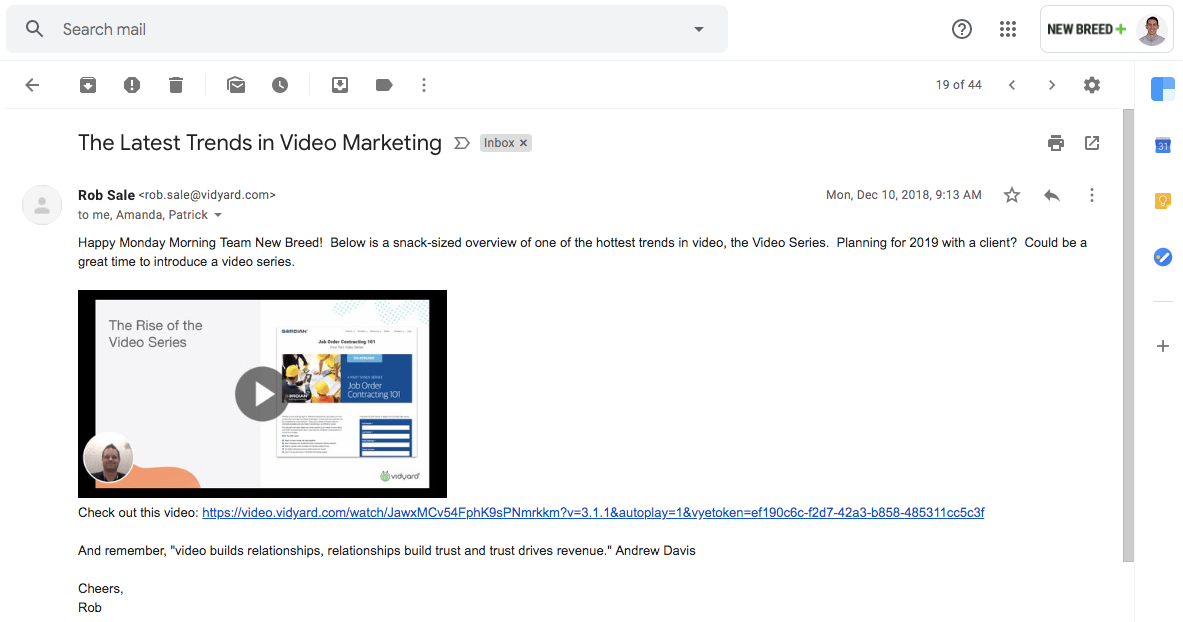5 Steps to Creating Terrific Product Messaging

When people think about product messaging, they usually start with the features and benefits the product provides. While those things do need to be defined, they should not be where you start developing your product messaging from.
Instead, your product messaging should lead with the intangible value your product provides to consumers. How does your product or service improve their life? Focus on how your product impacts their experience rather than the specific functions it offers. Features and benefits can contribute to that value, but they are not the overall value of your product.
Vidyard exemplifies how to lead with their core value before diving into product specifics on their about page, saying:
“Video is changing the way businesses connect and communicate in an increasingly digital world. From marketing, sales and customer service to employee training and corporate communications, video is helping businesses of all sizes humanize communications and personalize customer experiences.
Vidyard is the video platform that helps businesses transform communications and drive more revenue through the strategic use of online video. Going beyond video hosting and management, we help businesses connect with more viewers through interactive and personalized video experiences, learn powerful insights on their viewing audience, turn insights into action with enterprise integrations, and prove the impact of their video programs.”
In the first paragraph, they establish the value of their product, which is humanizing communications and personalizing customer experiences. Then they dive into the features and benefits of their product at a high level.
1. Understand the Core Value of Your Product
The core value of your product is the sum of all the benefits your product provides. It’s more than just the tactical solution your product can accomplish — it’s what that tactical solution is building toward in terms of overall goal attainment.
Your product’s core value should be concise, comprehensible, not jargony and easy to connect with.
2. Build a Story Around Your Product’s Core Value
Once you’ve fleshed out your product’s core value, show how that value looks in real life through a case study of how someone has experienced the value your product provides.
Many SaaS companies do this through the use of their own product.

For example, Vidyard will send you personalized videos once you enter their sales process to show off what their software can do. Plus, when you navigate their website, you’ll have the opportunity to engage with lots of video content. By using video in their marketing and sales strategies, they demonstrate the value of their product to prospective buyers.
That won’t work for every product though. If you can’t be your own case study, find a group of beta testers who can extract value from your product and will provide honest feedback. Allow them to use the product and then use their feedback to determine and refine your product messaging.
3. Conduct Market Research and Develop Buyer Personas
Now that you’ve seen how initial users have extracted value from your product, conduct market research to determine what type of people or companies will be able to gain similar value.
Once you identify who can benefit from your products, draft your buyer personas and extrapolate what messaging will resonate with them based on what you learned from your initial users.
Determine how your product can help your buyer personas, who will be involved in the purchasing decision and what your end-user will need to convince the buyer to make the purchase.
As you learn more about the people who’ll use your product, you’ll learn more about the companies they work at, and over time you’ll be able to refine your ideal customer profile (ICP) based on the companies who have the most success with your product.
4. Combine Your Core Value, Story and Research into Messaging That’ll Resonate with Your Buyer Personas
Once you know what the value of your product is and who you’re trying to market it to, use that knowledge to develop your product messaging.
Your messaging should start by explaining why the prospect should buy a solution like yours. That’s conveyed through your product’s core value. Then you explain why they should buy your product specifically, which you explain by showing how your product’s features and benefits address the prospect’s pain points.
You might frame your value proposition differently depending on the personas you’re addressing. The core value shouldn’t change, but the benefits you highlight might.
For example, Vidyard never strays from their core value of personalizing and humanizing communication through video. But, for prospects in sales, they highlight how Vidyard can be used to connect with prospects. When talking to marketers, they highlight how it can be used to modernize video strategies and engage with viewers.
5. Optimize and Refine Your Messaging
Over time, interview your customers to ensure you're highlighting the value and benefits that they’re receiving and not misrepresenting your product. The things your customers are consistently talking about should be part of your messaging.
In addition to learning more about how your customers are using your product to improve your messaging, also try to find out why closed-lost opportunities didn’t choose you.
Did a shortcoming of your messaging drive them to someone else? Once people are sold on the value, they’re going to look at your competitors too, so your messaging needs to set you apart.
Takeaway:
Nailing your product messaging is essential to ensure your product is adopted by customers. If the value proposition doesn’t align with what your product actually delivers, you’re going to generate unhappy customers or you won’t generate customers at all.
Avoid highlighting your features and benefits at the start of your messaging because while your product’s features might be what the end-user utilize to do their job, the value of your product — how those features help them reach their goals — is what will attract them to your solution initially.
Guido Bartolacci
Guido is Head of Product and Growth Strategy for New Breed. He specializes in running in-depth demand generation programs internally while assisting account managers in running them for our clients.





